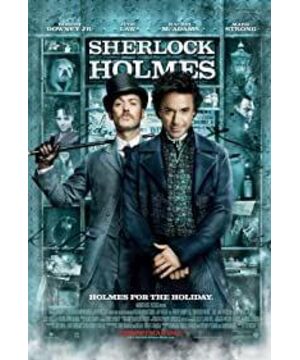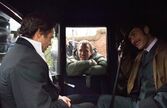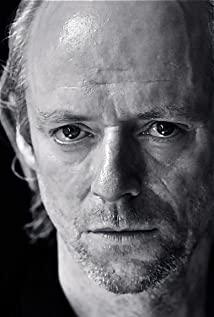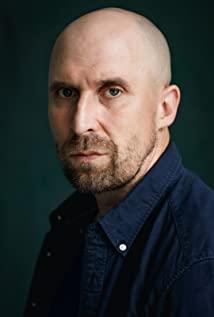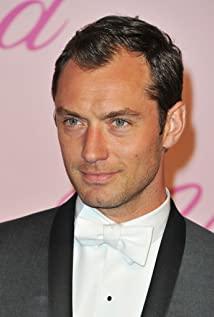Watching "The Detective Sherlock Holmes" is a very pleasant experience. Long before it was released, rumors about the gorgeous lineup and unreliable content of the film had flown all over the online world. The results of the visual verification on site are: gorgeous is real, unreliable is fake. The whole movie has both dazzling and exciting scenes and heavy and rigorous art. Although the story is inevitable, the director's excellent narrative skills made up for this defect and successfully completed a consumption and emphasis on detective classics in the new era. Structure. The stories
of classic
films that have been consumed can be said to be the clichés of detective films, with some religious suspense like "The Da Vinci Code". Encased in the mystery coat, it is actually a gambling battle between two rare talents, which is completely based on the competition of rationality and high IQ. Of course, close hand-to-hand combat is indispensable.
Sir Lockwood, played by Mark Strong, is said to be based on the British mysticist Aleister Crowley at the end of the nineteenth century. This man is not only proficient in all kinds of magic, but also founded a sect called "Fire and Power" , And openly claimed that Hitler had stolen the secret meaning of the swastika from himself. The British Empire at the end of the nineteenth century, to be precise, the whole of Europe was shrouded in a chaotic trend of thought, and the prosperity of reason and science did not bring hope to everyone. With the progress of industry and the process of colonization, the influx of various Eastern mysticisms, together with the huge social transformation, created countless supernatural events. As early as in Conan Doyle's original work, African indigenous and mysticism have become important elements. These are undoubtedly the source of inspiration for "Sherlock Holmes".
However, in the final analysis, the film still uses science to explain the mystery. In view of the fact that there were too many mysteries laid out in the first half, I finally had to explain and explain again. Of course, digging holes and filling pipes is a virtue and an obligation, otherwise the sequel will have no one to pay the bill. Guy Ritchie's "subversion" of scientific rationality is, in the final analysis, a consumption of irrational thoughts in the original work to attract attention.
The film's use of the "base feeling" between the two protagonists can also be viewed in the same way. "Detective Sherlock Holmes" is probably the first major commercial blockbuster movie to "sell rot" with great fanfare. Inside and outside of the film, the "radish syrup" and "peanuts" are inextricably mixed, and it is the director Guy Ritchie who is behind it. In today's Western society where reproduction is no longer necessary, sex is no longer confined between the two sexes, so the undercurrent of homosexuality, which has been surging for many years, can finally give birth to a new wave of aesthetics. Where there is a need, there is a market. This is the iron law of capitalism, and no one needs to have trouble with money. What's more, traditional morality has always been nothing more than a business in front of Hollywood.
The activated classic
consumer classic is another attempt to redesign the two characters Holmes and Watson from head to toe in the film. Holmes is not only strong and good at boxing, but also has a grumpy temper and a little nervousness. Watson became a tall and handsome guy, constantly stealing the limelight from Holmes. The most important thing is that all of this was discovered in the name of respecting Conan Doyle's original work. The director claimed that this is the original appearance of the good partner of the detectives.
What about the well-known image of Sherlock Holmes wearing a bowler hat and leaning on a civilized stick? Sorry, it is very likely that the image of a detective who has been "bleached" and is more in line with the middle-class aesthetics of the year. And this sloppy and impatient Sherlock Holmes, who haunts sewers and slaughterhouses all day long, is not only well-founded in the original work, but also obviously more in line with the aesthetic trend of pursuing "texture" today.
Similar to this, the film's gloomy and heavy exterior photography, together with the gorgeous and bright oil painting-like interior photography, successfully reproduced the style of London at the end of the nineteenth century. The director used a special photography technique called "Phantom" to successfully capture the rich details of dark places and moving objects, which were difficult to show in previous versions. The unfinished Tower Bridge in the film is an important background. Sherlock Holmes used it as a symbol of scientific progress at the beginning, and the final duel was also launched on the bridge, which clearly implies rational victory over evil. A magnificent surround panoramic lens "records" the "unfinished" of this landmark building, which is both novel and heavy. This edition of "Sherlock Holmes" is said to be subversive, but it is full of epic style in terms of art.
Guy Ritchie, as a representative of the post-modern trend in British film, is quite restrained in this new work. In order to activate the classics in his mind, he boldly used some non-linear narratives and sharp methods of jumping editing. However, it was by no means as dense as in his previous works. The result was that cold jokes were frequent without affecting the narrative. It feels very smooth. Although the story is clichéd, the narrative can always capture the audience's attention.
Hans Zimmer’s soundtrack definitely deserves credit. The music of the film is mainly string music, which is in line with Sherlock Holmes's hobby and is full of British national customs. The details are noisy, and the grand place is like a surging river, which perfectly sets off the plot.
In general, this version of "Holmes" has the calmness of a commercial film and the aura of an avant-garde director. It is an excellent commercial production. Conan Doyle's original work has been re-arranged and staged, stimulating the vigor that resonates with the present, and it also has some enlightening significance for the Chinese film industry with rich classics but not knowing whether to choose. The biggest shortcoming lies in the final climax, which is hitting high in the sky from the sewers, and the heroes and villains take turns hanging on the heights to survive. Hollywood has been shooting like this for decades, and I still enjoy it. It's really annoying. On the contrary, it's not as exciting as the action scenes in the middle.
Netease manuscript reprinted please indicate
View more about Sherlock Holmes reviews


